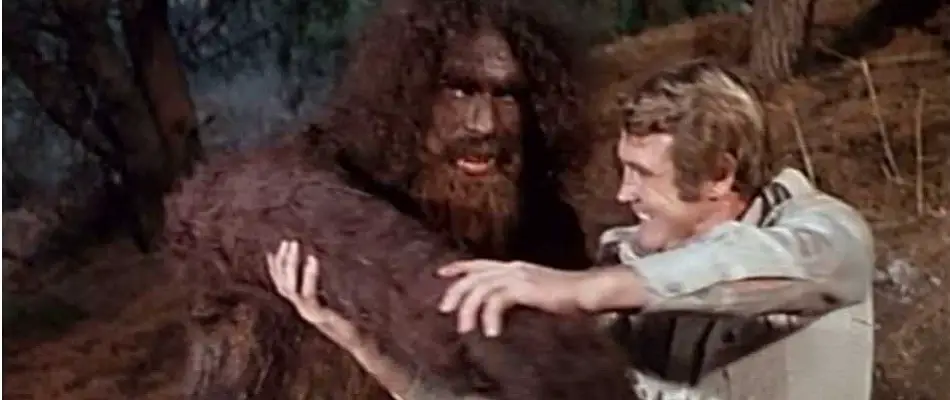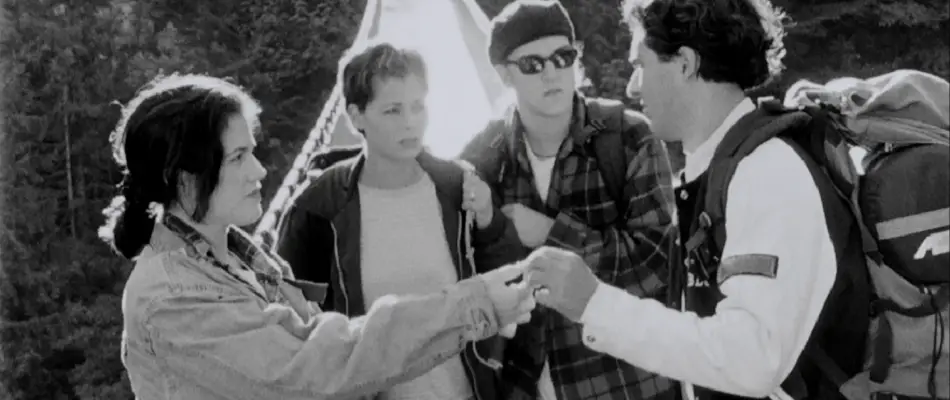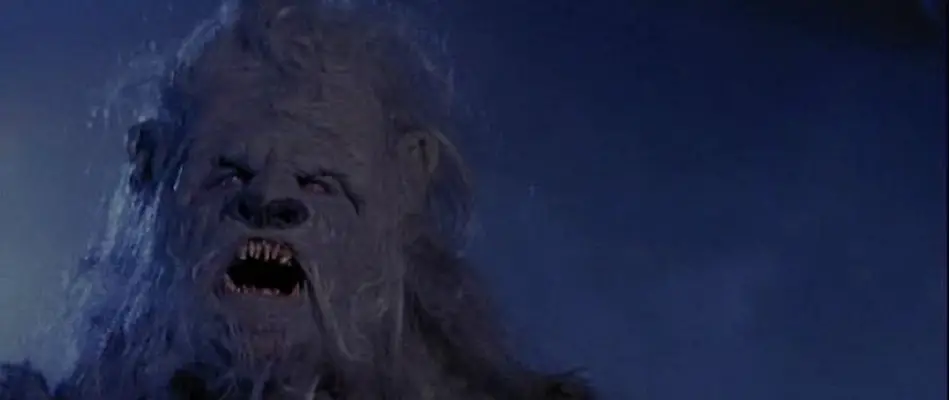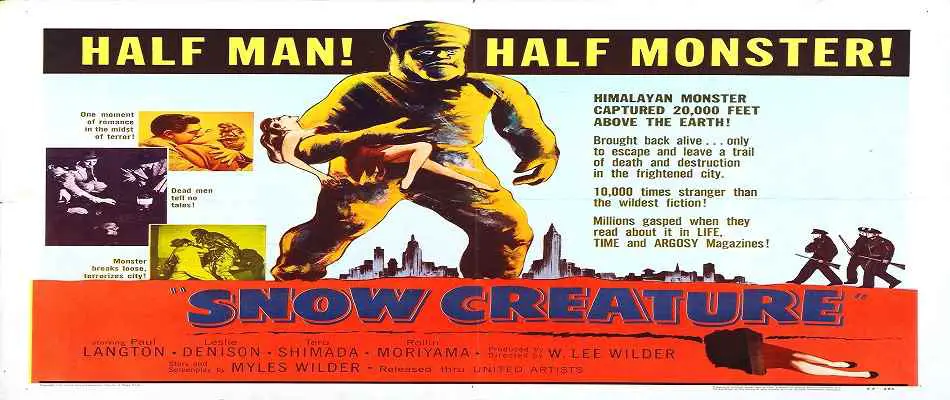Large, lumbering, hairy hominids that reside in wilderness areas and are rarely seen by human eyes. They are the stuff of myth and local legend, and although they were sometimes referred as “wildmen” in the past, most often each creature had its own name specific to the area where the sightings occurred. Today, they are more collectively called bigfoot, yeti, or the abominable snowman. Call them what you want, they’re all sasquatch to me.
The mystique that surrounds these creatures make them ideal subjects for storytelling, hence our continual fascination with them. There have been plenty of attempts by filmmakers to give us a quality representation of these behemoths—everything from children’s films to sex pictures—but how many of them have been good? That’s up to the brave individual viewer to decide as we take a look at the Cinematic Sasquatch.
It would be an impossible undertaking to detail every bigfoot film in such an abbreviated format, but I have attempted to cover most of the bases. Did I skip over your favorite? Feel free to call me out in the comments section and show your sasquatch love.
The first such film that I have been able to find evidence of is 1954’s The Snow Creature, about a scientific expedition that is forced to hunt a yeti when the creature kidnaps a woman from their group. They manage not only to rescue the woman but also to capture a yeti alive. Transported back to America, the creature escapes and it proceeds to terrorize the city. There are obvious parallels in plot between this film and 1933’s King Kong.
In 1955, Japan got in on the game with their kaiju take on the abominable snowman, Jû jin yuki otoko. Directed by Ishirō Honda, who had helmed the original Godzilla the year prior, the film was not without controversy. Its depictions of the indigenous Ainu people were apparently less than flattering, implying a history of inbreeding and violent behavior, eventually leading to the suppression of the film. Although the Japanese original is rather difficult to locate today, fans can still view segments of the movie. Much as they had done with Godzilla, new footage was shot with Western actors and the soundtrack and dialogue were replaced for the American release of the film in 1958, now known as Half Human.Man Beast, released in 1956 from schlock director Jerry Warren, and 1957’s The Abominable Snowman starring Peter Cushing, both capitalized on the myth of the cold and hairy beast. Even children’s programs presented their take, with Bugs Bunny and Daffy Duck facing the creature in Chuck Jones’s short The Abominable Snow Rabbit in 1961 (appearing again nearly two decades later in 1980’s Spaced Out Bunny), and the holiday favorite Rudolph the Red Nosed Reindeer in 1964.
Thus far, it was all about the snowbound version of our furry friend, but that changed in 1967 when friends Roger Patterson and Bob Gimlin returned from a trek in the Bluff Creek area of California with 16mm footage of a supposed bigfoot that they had encountered. Although the footage ran for less than a minute, the effect that it had would be felt for much, much longer. Skeptics were quick to call it a hoax (and today it has all but been proven as such), but it didn’t matter. People wanted to believe. More famous than any blatantly fictional encounter, this footage has been shown on countless television programs and documentaries. Filmmaker M. Night Shyamalan even mimicked it to great effect for one of the most chilling scenes of his career in 2002’s Signs.
 Once we entered into the 1970s, bigfoot was on its way to becoming a pop culture phenomenon. The 1970 film Bigfoot has bikers going toe-to-toe with the beast, John Carradine, and the timeless tagline “America’s Abominable Snowman Breeds with Anything!” Coming from the low-budget also-ran auteur Robert F. Slatzer, it is a less than stellar debut for the warm-weather yeti, but it can only improve from here.
Once we entered into the 1970s, bigfoot was on its way to becoming a pop culture phenomenon. The 1970 film Bigfoot has bikers going toe-to-toe with the beast, John Carradine, and the timeless tagline “America’s Abominable Snowman Breeds with Anything!” Coming from the low-budget also-ran auteur Robert F. Slatzer, it is a less than stellar debut for the warm-weather yeti, but it can only improve from here.
The Legend of Boggy Creek from 1972 revolves around the purportedly true accounts of the Fouke Monster, a “bigfoot-like” creature that haunts the area of Fouke, Arkansas. Director Charles B. Pierce did not return for the initial sequel, 1977’s Return to Boggy Creek (starring Dawn Wells and Dana Plato), but he did come back for the anomalously titled Boggy Creek II: And the Legend Continues from 1985. The 2010 reboot of the franchise, Boggy Creek: The Legend is True, changed the setting to Texas, though 2011’s The Legacy of Boggy Creek returned back to the roots of the original films.
Notorious exploitationers Michael and Roberta Findlay brought us Shriek of the Mutilated in 1974, in which a group of doomed college students and their professor go searching for the yeti and are killed off in rapid succession. Despite the twist ending, it still earns its place here.
1975’s Night of the Howling Beast (AKA The Werewolf and the Yeti) from Paul Naschy has his famous werewolf character Waldemar Daninsky as part of an expedition in the Himalayas to find the yeti. The same year, the live-action Filmation series The Secrets of Isis featured what a group of students thought to be bigfoot, but actually turned out to be nothing more than a hairy hermit—an easy mistake to make.
Similarly, in 1976 a two-part episode of The Six Million Dollar Man featured Steve Austin encountering what appeared to be a bigfoot…but was actually a robot created by visiting aliens. The bigfoot here was played by professional wrestler Andre the Giant, but when the creature returned for another two-episode stint later the same year, and once more in 1977, he was portrayed by Ted Cassidy, more famous as Lurch from The Addams Family. Also in 1976, the Sid & Marty Krofft show Land of the Lost featured an episode in which the Marshall family encounters not only a unicorn, but the abominable snowman, as well.
 Not all of bigfoot’s appearances from 1976 were relegated to television, though. He also cropped up in the low-budget Creature from Black Lake, from Joy N. Houck, Jr.; and the absurd Curse of Bigfoot, which took a student film from 1958, added new wraparound footage to pad it out to feature-length, and tells the story of a group of teenagers who accidentally resurrect a mummified bigfoot from hibernation.
Not all of bigfoot’s appearances from 1976 were relegated to television, though. He also cropped up in the low-budget Creature from Black Lake, from Joy N. Houck, Jr.; and the absurd Curse of Bigfoot, which took a student film from 1958, added new wraparound footage to pad it out to feature-length, and tells the story of a group of teenagers who accidentally resurrect a mummified bigfoot from hibernation.
In 1977, we got Sasquatch: The Legend of Bigfoot from director Ed Ragozzino, otherwise known for his narration of Christian faith documentaries; the made-for-television Snowbeast from Joseph Stefano, scriptwriter of Hitchcock’s Psycho, about a yeti terrorizing a Colorado ski resort; the Italian King Kong riff Giant of the 20th Century; and just in case you didn’t get enough Krofft-style sasquatch from its appearance in Land of the Lost, we saw the premiere of Bigfoot and Wildboy, which started as a segment on The Krofft Supershow before spinning off into its own series in 1979. Basically The Jungle Book with Mowgli being raised by sasquatch instead of animals, the unlikely duo battled space aliens, pollution, and injustice every week. The same year that it received its own series, George “Buck” Flower went up against the yeti in the theatrical The Capture of Bigfoot.
In 1980, bigfoot amped up the bloodshed in Night of the Demon, so much so that it landed on the “video nasty” list. At one point, he rips out somebody’s intestines and proceeds to use them to beat the dead man’s companions. Perhaps movie producers thought that they had reached a cinematic high (or low) with this one, or maybe the interest was just no longer there, but for whatever reason, sasquatch disappeared from film for a sizable chunk of time after this.
When bigfoot finally returned to the screen in 1987, he was far from the vicious creature that we had last seen him portrayed as. This was the year of the Family Friendly ‘Foot, befriending a young boy in Cry Wilderness, visiting Walt Disney’s Wonderful World of Color for the TV movie Bigfoot, and most famously being adopted by John Lithgow & Co. in Harry and the Hendersons. The latter even became a television series in 1991, which lasted for three seasons.
 Demonwarp from 1988 appeared as if it were going to return bigfoot to his bloody roots, but it utilized a kitchen sink approach to its horror, featuring not only sasquatch but also zombies and extraterrestrials. This film featured George Kennedy and adult film actress/scream queen Michelle Bauer, and sent the sasquatch scuttling back into the shadows for another lengthy hibernation.
Demonwarp from 1988 appeared as if it were going to return bigfoot to his bloody roots, but it utilized a kitchen sink approach to its horror, featuring not only sasquatch but also zombies and extraterrestrials. This film featured George Kennedy and adult film actress/scream queen Michelle Bauer, and sent the sasquatch scuttling back into the shadows for another lengthy hibernation.
1995 saw the monster reemerge in a pair of kiddie flicks. To Catch a Yeti stars Meat Loaf and a miniature yeti which amounts to little more than a hand puppet, bearing absolute resemblance to the mythological beast we have come to love; and Legend of the Desert Bigfoot, an entry in the Christian franchise Last Chance Detectives from Focus on the Family. In order to avoid any dangerous associations of evolution, it is actually yet another case of mistaken identity, and our heroes find that the bigfoot in question is really just a kindhearted gorilla.
Bigfoot tried to get some indie film cred with 1996’s Drawing Flies, executive produced by Kevin Smith and Scott Mosier, fresh from the food court in Mallrats. It utilized a good chunk of the same cast, but the creature appears only in dream sequences. It should also be noted that the idea for the lead character’s bigfoot hunt came about by watching reruns of The Six Million Dollar Man.
 As if the miniature monster in To Catch a Yeti was not saccharine enough, 1997 gave us the release of Little Bigfoot starring P.J. Soles, whose son must stop an evil logging company from destroying his hairy pal’s habitat. It was followed only months later with Little Bigfoot 2: The Journey Home. The same year, we also got the comedic mockumentary The Sasquatch Hunters and the poorly-regarded horror Search for the Beast from the one-and-done director R.G. Arledge.
As if the miniature monster in To Catch a Yeti was not saccharine enough, 1997 gave us the release of Little Bigfoot starring P.J. Soles, whose son must stop an evil logging company from destroying his hairy pal’s habitat. It was followed only months later with Little Bigfoot 2: The Journey Home. The same year, we also got the comedic mockumentary The Sasquatch Hunters and the poorly-regarded horror Search for the Beast from the one-and-done director R.G. Arledge.
The made-for-television movie Big and Hairy debuted in 1998, and showed us what kind of mad skills Bigfoot brings to the basketball court. I admittedly haven’t seen it, but can only assume that you would be better served sticking with Teen Wolf.
Pixar’s Monsters Inc.showed us a computer animated abominable snowman in 2001, and the character, voiced by John Ratzenberger, made a return engagement in the 2013 prequel Monsters University.
2002’s The Untold attempted to steer the sasquatch back into horror territory, but even the presence of genre stalwart Lance Henricksen couldn’t salvage this one from the junk pile. The same can be said of 2004’s Among Us from low-budget filmmaker Jon McBride and Suburban Sasquatch from Dave Wascavage; 2005’s The Unknown from Karl Kozak; and 2006’s Abominable from Ryan Schifrin. In the wake of these failures, bigfoot returned once again to the stuff of punchlines and kiddy fare.
2006 saw the release of The Sasquatch Gang starring Justin Long; Yeti: A Love Story, about a homosexual sasquatch on the prowl; and The Lumberjack of All Trades from Matthew LaCurtis, who seemed to be a jack of all trades himself on this film, but his only other credit is as producer of the 2012 documentary My Amityville Horror. Steve Zahn, Jonah Hill and Justin Long (again) went hunting for bigfoot in 2008’s Strange Wilderness, but all they found was the same thing as the audience: disappointment.
The Sci-Fi Channel produced the notoriously bad Yeti: Curse of the Snow Demon in 2008, notable if for only the scene in which the beast tears off a man’s arm and then beats him to death with it (echoing the intestine beating we saw in 1980’s Night of the Demon). The same year, we also received The Wild Man of the Navidad, claiming to be based on the journals of a Texan whose small town was terrorized by bigfoot.
 James Baack’s The Bloody Rage of Bigfoot from 2010 gets a special mention for sheer audacity, as it runs for damn near three hours in length and features psychotic clowns alongside the monster mayhem. The indie drama Letters from the Big Man from 2011 was decidedly not a horror film, but was pretty well-received by critics and makes no attempt to obscure the sasquatch, placing him on full display. Exploitation throwback film Dear God No! was also released in 2011 but hearkens back to the 1970s, pitting a gang of bikers against a bloodthirsty sasquatch (and pretty much everything and everyone else). The same year, sasquatch went softcore for the sex comedy Sweet Prudence and the Erotic Adventures of Bigfoot, if hirsute men is your thing.
James Baack’s The Bloody Rage of Bigfoot from 2010 gets a special mention for sheer audacity, as it runs for damn near three hours in length and features psychotic clowns alongside the monster mayhem. The indie drama Letters from the Big Man from 2011 was decidedly not a horror film, but was pretty well-received by critics and makes no attempt to obscure the sasquatch, placing him on full display. Exploitation throwback film Dear God No! was also released in 2011 but hearkens back to the 1970s, pitting a gang of bikers against a bloodthirsty sasquatch (and pretty much everything and everyone else). The same year, sasquatch went softcore for the sex comedy Sweet Prudence and the Erotic Adventures of Bigfoot, if hirsute men is your thing.
David DeCocteau brought the sasquatch into his 1313 series of homoerotic horror with the 2012 entry 1313: Bigfoot Island. Also from 2012, former child stars Danny Bonaduce and Barry Williams competed to find the creature in the made-for-TV Bigfoot; we saw the found footage horrors of The Lost Coast Tapes; the “B is for Bigfoot” segment of the anthology film The ABCs of Death, from Adrian Garcia Bogliano; and the family-friendly animated feature Hotel Transylvania.
Bobcat Goldthwait may seem like an unlikely person to tackle the bigfoot myth, but he did just that with 2013’s Willow Creek, which, if nothing else, was amazingly well researched. And in 2014, David DeCocteau gave it another shot with the ludicrously titled Bigfoot Vs. D.B. Cooper, which pretty much puts it all in the title. Also in 2014, we got another found footage film from Eduardo Sanchez, one of the creators of The Blair Witch Project. The reviews have been mixed, partly because of the bad reputation that found footage films have earned over the years, but it is certainly a step in the right direction for the genre fan who longs for a solid entry in the deadly cinema of sasquatch.
 With at least three more entries in various stages of production—Woodwalkers from television director David Winning; The Legend of Grassman from Dennis and Tyler Meyer; and Bigfoot: Blood Trap from John Orrichio—perhaps 2015 will finally bring us the epic bigfoot horror that we have all been waiting for. Fingers (or toes) crossed.
With at least three more entries in various stages of production—Woodwalkers from television director David Winning; The Legend of Grassman from Dennis and Tyler Meyer; and Bigfoot: Blood Trap from John Orrichio—perhaps 2015 will finally bring us the epic bigfoot horror that we have all been waiting for. Fingers (or toes) crossed.








